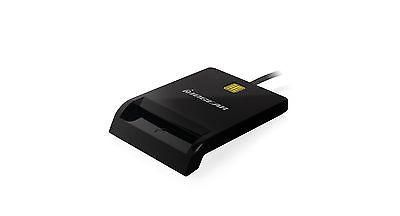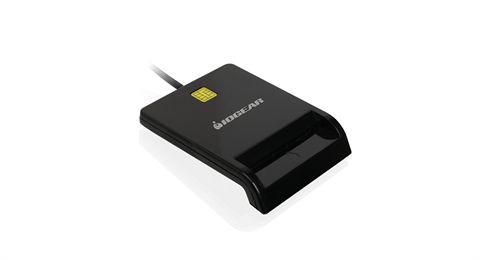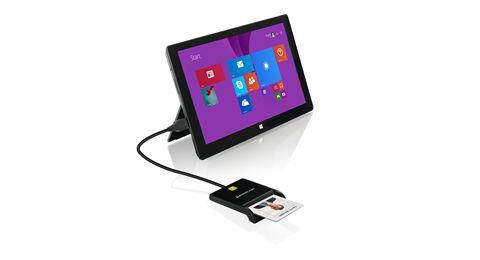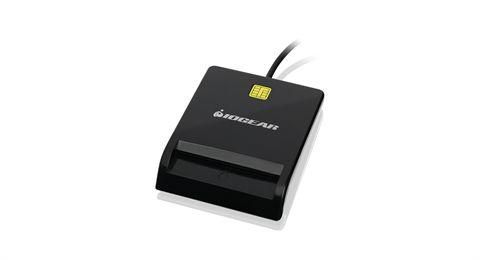- Accueil
- Surveillance & sécurité
- Contrôle d'accès
- Lecteurs
- Lecteurs de contrôle d'accès
- IOGEAR EMV 4.1, T0, T1, APDU, USB – GSR212
IOGEAR EMV 4.1, T0, T1, APDU, USB
MPN GSR212
EAN / UPC 881317512482
Niveau de stock
Smart Card Reader / CAC Reader
IOGEAR's USB Common Access Card Reader is the perfect solution for most civilians as well as non-military government workers who need everyday secure access. Common Access Card (CAC), or Smart Card readers are often used as a communications medium between the EMV smart card and a host (e.g. a computer, a point-of-sale terminal, network login, etc.) in secure systems such as those used by government, banking and health care.
The GSR212 requires ...
Caractéristiques GSR212
Connectivité
Connexion à un PC
USB 2.0
Connexion PC
Oui
Longueur maximale du câble
1,01 m
Détails techniques
Clavier intégré
Non
Couleur du produit
Noir
L'accès à puce / lecteur de carte
Oui
Lecteur d'empreintes digitales
Non
Lecteur de code d'accès
Non
Longueur maximale du câble
1,01 m
Prise en charge du système d'exploitation Linux
Oui
Prise en charge du système d'exploitation Mac
Oui
Prise en charge du système d'exploitation Windows
Oui
Type d'authentification
carte d'accès
Écran
Écran integré
Non
Package dimensions (verified)
Depth Verified
14,1 cm
Gross Weight Verified
0,1 kg
Height Verified
3,8 cm
Width Verified
17,3 cm
Product dimensions
Height (product,cm)
0,97 cm
Net Weight (Product, kg)
0,05 kg
Product Depth
8,26 cm
Product Width
6,35 cm
Vendor information
Brand Name
Warranty
3 Année (s)
Description
EMV 4.1, T0, T1, APDU, USB
Smart Card Reader / CAC Reader
IOGEAR's USB Common Access Card Reader is the perfect solution for most civilians as well as non-military government workers who need everyday secure access. Common Access Card (CAC), or Smart Card readers are often used as a communications medium between the EMV smart card and a host (e.g. a computer, a point-of-sale terminal, network login, etc.) in secure systems such as those used by government, banking and health care.
The GSR212 requires the card to be inserted directly into the reader where electrical contacts retrieve the data stored in the card’s chipset. IOGEAR’s physical contact readers are less prone to misalignment, which helps to eliminate the possibility of being misread.
What is a Smart Card or Common Access Card?
Often referred to as a Smart Card, the Common Access Card (or CAC) is the next generation in secure identification technology. Having the same shape as a credit card, every Smart Card features an embedded data chip allowing the user's identification to be electronically verified when accessing secured systems. In addition to the embedded chip, Smart Cards are usually programmed with a PIN to ensure security for both the card holder and the system being accessed. Unlike the magnetic strips found on traditional credit cards, the EMV cards uses multiple layers of security. This chip and pin technology provides higher security by storing more encrypted data, avoiding data breach. IOGEAR's USB Common Access Card Reader (Non-TAA) uses a contact system where the card must be inserted directly into the card reader; this type of reader is less prone to misalignment and eliminates the possibility of being misread. When it comes to secure access, the Common Access Card (or Smart Card) is an evolutionary step in convenience and security.
Having reached tremendous adoption rates outside of the U.S., Smart Cards are now rapidly growing in this country to combat credit card fraud, while also providing next generation security and user friendly identification. The federal government issues Common Access Cards programmed with a Personal Identification Verification (PIV) chip containing the data necessary for the cardholder to be properly identified and granted access to secure federal facilities and information systems. Smart Cards have been in use by the federal government in accordance with Homeland Security Presidential Directive 12 (HSPD-12) since 2006, and now the technology is rapidly spreading to banking, healthcare and other areas requiring identity verification and secured access.
- Support EMV Level 1 specification
- Designed for use with CAC middleware (not included)
- Supports PC Smart Card industry standard - PC/SC version 1.0/2.0
- ISO7816 implementation - Class A, B, and C (5V / 3V / 1.8V) Card
- Support T0, T1 protocol
- EMV 4.1 compliant
- Supports popular memory cards including: SLE 4404, 4418, 4428, 4442, 4443, and I2C
- Support short APDU and extended APDU
- Compatible with Microsoft USB-CCID driver
- Compliant with USB CCID Transport Specification Rev 1.1
- Low power consumption
- Display function: LED display to show system operation and power status
- Dual Multi-protocol Smart Card Interface: Main Card & Auxiliary Card
- Compliant with ISO 7816, EMV2000, GIE-CB and WHQL Standards.
- Asynchronous Protocol T=0 & T=1, with Direct and Inverse Modes.
- Supports CPU-based cards with ISO 7816 T=0 and T=1protocol and 2 and 3 wire Memory Cards or 12C interface synchronous card
- FIPS-201 Compliant
- Suitable for applications in government, healthcare, banking, and secure network login
*Les données produit ci-dessus sont fournies par Icecat. A cet égard, EET ne peut être tenu responsable des erreurs.








